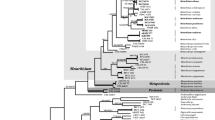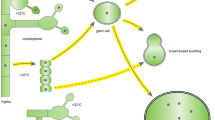Abstract
The aggressive subgroup of the Dutch elm disease pathogen Ophiostoma ulmi (Buism.) Nannf. syn. Ceratocystis ulmi (Buism.) Moreau is named as a new species, O. novo-ulmi, and is thereby separated from the ‘old’ non-aggressive subgroup, which is retained as O. ulmi. O. novo-ulmi differs from O. ulmi in colony morphology, growth rate, optimum temperature for growth, perithecial neck length, pathogenicity to elm, bark colonising ability, cerato-ulmin protein production, synnemetal and protoperithecial production, mating type frequency, protein and isozyme polymorphisms, mitochondrial DNA and nuclear DNA polymorphisms, and mitochondrial DNA size. In addition, a strong unidirectional fertility barrier operates between the two species, while their hybrids show remarkable variation, poor fitness, and many are infertile. These aspects are summarised. New information on perithecial dimensions is presented. O. ulmi is redefined and a neotype designated. The status of the Eurasian and North American races of O. novo-ulmi is currently under investigation.
Similar content being viewed by others
Abbreviations
- EAN:
-
Eurasian race
- NAN:
-
North American race
References
Barrett DK, Skidmore AM. Metabolite of Ceratocystis ulmi and its association with pathogenicity. Trans Br mycol Soc 1975; 65: 469–75
Bates M. DNA polymorphism in the Dutch elm disease fungus, Ophiostotna ulmi. PhD thesis, University of London, 1990.
Bates MR, Brasier CM, Buck KW. Dutch elm disease. Molecular relationships of the O. ulmi subgroups. Source of rapid variation in the aggressive subgroup at current epidemic fronts. Report on Forest Research (HMSO, London) 1991 (in press).
Bates MR, Buck KW, Brasier CM. Molecular variation in the Dutch elm disease fungus. In: Clegg MT, O'Brian SJ (eds), Molecular Evolution. UCLA Symposia on Molecular and Cellular Biology New Series, 1991; 122: 171–78.
Bernier L, Jeng RS, Hubbes M. Differentiation of aggressive and non-aggressive strains of Ceratocystis ulmi by polyacrylamide gel electrophoresis of intramycelial enzymes. Mycotaxon 1983; 17: 456–72.
Brasier CM. Inheritance of pathogenicity and cultural characters in Ceratocystis ulmi. Hybridisation of protoperithecial and non-aggressive strains. Trans Br mycol Soc 1977; 68: 45–52.
Brasier CM. Mites and reproduction in Ceratocystis ulmi and other fungi. Trans Br mycol Soc 1978; 70: 81–9.
Brasier CM. Dual origin of recent Dutch elm disease outbreaks in Europe. Nature Lond 1979; 281: 78–9.
Brasier CM. Laboratory investigation of Ceratocystis ulmi. In: Stipes RJ, Campana RJ (eds), Compendium of Elm Diseases. American Phytopathological Society, 1981; 76–9.
Brasier CM. Genetics of pathogenicity in Ceratocystis ulmi and its significance for elm breeding. In: Heybroek HM, Stephan BR, von Weissenberg K (eds), Resistance to Diseases and Pests in Forest Trees. Wageningen (Netherlands): Pudoc 1982; 224–35.
Brasier CM. Occurrence of three sub-groups within Ceratocystis ulmi. In: Kondo ES, Hiratsuka Y, Denyer WBC (eds) Proceedings of the Dutch Elm Disease Symposium and Workshop, Winnipeg, Manitoba, October 5–9. Manitoba, (Canada): Manitoba Department of Natural Resources 1982; 298–321.
Brasier CM. Dutch elm disease. The origin of Dutch elm disease. Report on Forest Research (HMSO. London) 1983: 32.
Brasier CM. The future of Dutch elm disease in Europe. In: Burdekin DA (ed), Research on Dutch Elm Disease in Europe. Forestry Commission Bulletin (HMSO, London) 1983; 60: 96–104.
Brasier CM. Inter-mycelial recognition systems in Ceratocystis ulmi: their physiological properties and ecological importance. In: Jennings D, Rayner ADM (eds), The ecology and physiology of the fungal mycelium. Cambridge University Press 1984; 451–97.
Brasier CM. A comparison of pathogenicity and cultural characteristics in the EAN and NAN aggressive subgroups of Ophiostoma ulmi. Trans Br mycol Soc 1986; 87: 1–13.
Brasier CM. Some genetical aspects of necrotrophy with special reference to Ophiostoma ulmi. In: Day PR, Jellis GJ (eds), Genetics and Plant Pathogenesis. Oxford: Blackwell Scientific Publications 1986; 297–310.
Brasier CM. Dutch elm disease — Ophiostoma (Cerato cystis) ulmi. The emergence of EAN and NAN hybrids in Europe. Report on Forest Research (HMSO, London) 1986: 37.
Brasier CM. The population biology of Dutch elm disease: its principal features and some implications for other host-pathogen systems. In: Ingram DS, Williams PH (eds). Advances in Plant Pathology. London and New York: Academic Press 1986; Vol 5: 55–118.
Brasier CM. Recent genetic changes in the Ophiostoma ulmi populations: the threat to the future of the elm. In: Wolfe MS, Caten CE (eds), Populations of Plant Pathogens. Oxford: Blackwell Scientific Publications 1987; 213–26.
Brasier CM. (Genetic systems in) Ophiostoma ulmi, cause of Dutch elm disease. In: Sidhu GS (ed), Genetics of Plant Pathogens. Adv Pl Path. London and New York: Academic Press 1988; 6: 207–23.
Brasier CM. Rapid changes in genetic structure of epidemic populations of Ophiostoma ulmi. Nature Lond 1988; 332: 538–41.
Brasier CM. China and the origins of Dutch elm disease: an appraisal. Pl Path 1990; 39: 5–16.
Brasier CM. The unexpected element: mycovirus involvement in the outcome of two recent pandemic events, Dutch elm disease and chestnut blight. In: Burdon JJ, Leather SR (eds), Pests, Pathogens and Plant Communities. Oxford: Blackwell Scientific Publications 1990; 289–308.
Brasier CM, Afsharpour F. The aggressive and non-aggressive strains of Ceratocystis ulmi in Iran. Eur J Forest Pathol 1979; 9: 113–22.
Brasier CM, Gibbs JN. Variation in Ceratocystis ulmi: Significance of the aggressive and non-aggressive strains. In: ‘Dutch elm disease’ (Proceedings of the IUFRO Conference, Minneapolis — St Paul September 1973). USDA Forest Service, Northeastern Forest Experiment Station 1975; 53–6.
Brasier CM, Gibbs JN. Inheritance of pathogenicity and cultural characters in Ceratocystis ulmi, I: Hybridisation of aggressive and non-aggressive strains. Ann Appl Biol 1976; 83: 31–7.
Brasier CM, Lea J, Rawlings MK. The aggressive and non-aggressive strains of Ceratocystis ulmi have different temperature optima for growth. Trans Br mycol Soc 1981; 76: 213–8.
Brasier CM, Rayner ADM. Whither terminology below the species level in the fungi? In: Rayner ADM, Brasier CM, Moore D (eds), Evolutionary Biology of the Fungi. Cambridge University Press 1987; 379–88.
Brasier CM, Takai S, Nordin JH, Richards NC. Differences in cerato-ulmin production between the EAN, NAN and non-aggressive subgroups of Ophiostoma ulmi. Pl Path 1990; 39: 231–236.
Bruns TD, Palmer JD, Shumard DS, Grossman LI, Hudspeth MES. Mitochondrial DNAs of Suillus: Three fold size change in molecules that share a common gene order. Curr Genetics 1988; 13: 49–56.
Buisman C. Ceratostomella ulmi, de geslachtelijke vorm van Graphium ulmi Schwarz. Tijdschr PlZiekt 1932; 38: 1–8.
Crane JL, Schoknecht JD. Conidiogenesis in Ceratocystis ulmi, Ceratocystis piceae and Graphium penicillioides. Am J Bot 1973; 60: 346–54.
Dewey FM, Munday CJ, Brasier CM. Monoclonal antibodies to specific components of the Dutch elm disease pathogen Ophiostoma ulmi. Pl Path 1989; 38: 9–20.
Förster H, Coffey M. Molecular approaches in Phytophthora taxonomy using polymorphisms in mitochondrial and nuclear DNA. In: Lucas J, Shattock RC, Shaw DS, Cooke L (eds), ‘Phytophthora’ Cambridge University Press 1991 (in press).
Forster H, Kinscherf TG, Leong SA, Maxwell DP. Estimation of relatedness between Phytophthora species by analysis of mitochondrial DNA. Mycologia 1988; 80: 466–78.
Gibbs JN. Intercontinental epidemiology of Dutch elm disease. Ann Rev Phytopathol 1978; 16: 287–307.
Gibbs JN, Brasier CM. Correlation between cultural characters and pathogenicity in Ceratocystis ulmi from Europe and North America. Nature Lond 1973; 241: 381–83.
Gibbs JN, Brasier CM, Heybroek HM, McNabb HS. Further studies on the pathogenicity of Ceratocystis ulmi. Eur J Forest Pathol 1975; 5: 161–74.
Gibbs JN, Houston DR, Smalley EB. Aggressive and non-aggressive strains of Ceratocystis ulmi in North America. Phytopath 1979; 69: 1215–19.
Hoog GS de. The genera Blastobotrys, Sporothrix, Calcarisporium and Calcarisporiella gen. nov. Stud Mycol 1974; 7: 1–84.
Hoog GS de, Scheffer R. Ceratocystis versus Ophiostoma: a reappraisal. Mycologia, 1984; 76: 292–99.
Houston DR. Spread and increase of Ceratocystis ulmi with cultural characteristics of the aggressive strain in northeastern north America. Pl Dis 1985; 69: 677–80.
Hunt J. Taxonomy of the genus Ceratocystis. Lloydia 1956; 19: 1–58.
Jeng RS. Analytical electrofocusing and two-dimensional electrophoresis of proteins extracted from the mycelia of aggressive and nonaggressive strains of Ophiostoma ulmi. Canad J Bot 1986; 64: 2073–81.
Jeng RS, Bernier L, Brasier CM. A comparative study of cultural and electrophoretic characteristics of the Eurasian and North American races of Ophiostoma ulmi. Canad J Bot 1988; 66: 1325–33.
Jeng RS, Duchesne LC, Sabourin M, Hubbes M. Mitochondrial DNAs restriction fragment length polymorphisms of aggressive and non-aggressive isolates of Ophiostoma ulmi. Mycol Res 1991 (in press)
Jeng RS, Hubbes M. Identification of aggressive and nonaggressive strains of Ceratocystis ulmi by polyacrylamide gel electrophoresis of intramycelial proteins. Mycotaxon 1983; 17: 445–55.
Kile GA, Brasier CM. Inheritance and inter relationship of fitness characters in progeny of an aggressive × nonaggressive cross of Ophiostoma ulmi. Mycol Res 1990; 94: 514–522.
Melin E, Nannfeldt JA. Researches into the blueing of ground woodpulp. Sven Skogsvardsfoeren Tidskr 1934; 32: 397–616.
Mitchell AG. Interaction between the aggressive and non aggressive subgroups of Ophiostoma ulmi. 1988; PhD thesis, University of Bath, UK.
Mittempergher L. Dutch elm disease in Italy: the status of the disease and aggressiveness of the isolates of Ceratocystis ulmi. Riv Patol veg 1981; 17: 115–25.
Moreau C. Coexistence des formes Thielaviopsis et Graphium chez une souche de Ceratocystis major (van Beyma) nov comb Remarques sur les variations des Ceratocystis. Revue mycol 17: Supplement Colonial 1952; 1: 17–25.
Moulemans M, Gelfus F, Ramaekers D, Freyer K, Mertens P. Identification, caractérisation et repartition des souches et races d'Ophiostoma ulmi (Buism) Nannf en Belgique. Parasitica 1981; 38: 15–26.
Munoz Lopez C. La grafiosis del olmo en Espana. Nuevos aislamientos de la cepa agresiva. Boln Estac cent ecologia (ICONA) 1985; 14: 65–76.
Pusey L, Wilson GL. Toxin production and pathogenicity of Ceratocystis ulmi. J Arbor 1981; 7: 258–60.
Scheffer RJ, Elgersma DM. A scanning electron microscope study of cell-wall degradation in elm wood by aggressive and non-aggressive isolates of Ophiostoma ulmi. Eur J Forest Pathol 1982; 12: 25–8.
Scheffer RJ. Liem JI, Elgersma DM. Production in vitro of phytotoxic compounds by non-aggressive and aggressive isolates of Ophiostoma ulmi, the Dutch elm disease pathogen. Physiol Molec Pl Path 1987; 30: 321–5.
Schreiber LR, Townsend AM. Variability of aggressiveness, recovery and cultural characteristics of isolates of Ceratocystis ulmi. Phytopath 1976; 66: 239–44.
Schwarz M-B, Das Zweigensterben der Olmen, Trauerweiden und Pfirschbaume. Meded phytopath Lab Willie Commelin Scholten 1922; 5: 1–73.
Smith ML, Anderson JB. Restriction fragment length polymorphisms in mitochondrial DNAs of Armillaria: identification of North American biological species. Mycol Res 1989; 93: 247–56.
Svaldi R, Elgersma DM. Further studies on the activity of cell wall degrading enzymes of aggressive and non aggressive isolates of Ophiostoma ulmi. Eur J Forest Pathol 1982; 12: 29–36.
Takai S. Pathogenicity and cerato-ulmin production in Ceratocystis ulmi. Nature Lond 1974; 252: 124–6.
Takai S. Relationship of the production of the toxin cerato-ulmin with synnemta formation, pathogenicity, mycelial habit and growth of Ceratocystis ulmi. Canad J Bot 1980; 58: 658–62.
Taylor JW, Natvig DO. Mitochondrial DNA and evolution of heterothallic and pseudohomothallic Neurospora species. Mycol Res 1989; 93: 257–72.
Tchernoff B. Methods for screening and for the rapid selection of elms for resistance to Dutch elm disease. Acta bot neerl 1965; 14, 409–452.
Upadhyay HP. A monograph of Ceratocystis and Ceratocystiopsis. Athens, Georgia: The University of Athens Press 1981.
Webber JF, Hedger JN. Comparisons of interactions between Ceratocystis ulmi and elm bark saprobes in vitro and in vivo. Trans Br mycol Soc 1986; 86: 93–101.
Author information
Authors and Affiliations
Rights and permissions
About this article
Cite this article
Brasier, C.M. Ophiostoma novo-ulmi sp. nov., causative agent of current Dutch elm disease pandemics. Mycopathologia 115, 151–161 (1991). https://doi.org/10.1007/BF00462219
Received:
Accepted:
Issue Date:
DOI: https://doi.org/10.1007/BF00462219




